Randy Ellefson's Blog, page 22
June 17, 2019
What’s a Privateer?
A privateer is not a ship type but any ship operated by private individuals, or a group of them, for profit. They are given the right, via a letter of marque, to engage in acts of war on the seas by their sovereign power, which takes a percentage of any captured prize. Profits are otherwise split among crew and owners. The possession of the letter of marque, and the return and sale of prizes to the sovereign power, is what distinguishes a privateer from a pirate.
Not surprisingly, some pirates sought the letters (often illegally) to absolve their actions. Others acquired letters from opposing countries at war (not admitting to this, of course). They then attacked both sides as desired. For example, a privateer might have letters of marque from England and from France, using the former against French ships and the latter against English. Only he and his crew, and possible owners, might know this.
Privateers who didn’t return captured prizes, or who otherwise violated their agreement, could be declared pirates. Some countries refused to recognize the letters of marque from their enemies and hanged captured privateers as pirates, or at least threatened to, leading to negotiations for an exchange of prisoners, for example.
As for the ships, they were heavily armed, fast, and highly maneuverable, as they were intended purely for assault. Since they captured ships and sailed them back (treasure inside), there was arguably less need for their own cargo space beyond provisions. Anything larger than a frigate was unsuitable (i.e., no ships-of-the-line).
The post What’s a Privateer? appeared first on The Art of World Building.
June 13, 2019
Sloop vs. Sloop-of-war
To most of us, a sloop is basically a sail boat, having a single mast that is fore-and-aft rigged. If there are two masts, it’s called a cutter instead (and is typically larger). There are other minor variations on this, each with a different name, but they are not ships of war and therefore might only figure in our work if our characters need a small, wind-powered vessel. Another option would be the galley (oar-powered long ship).
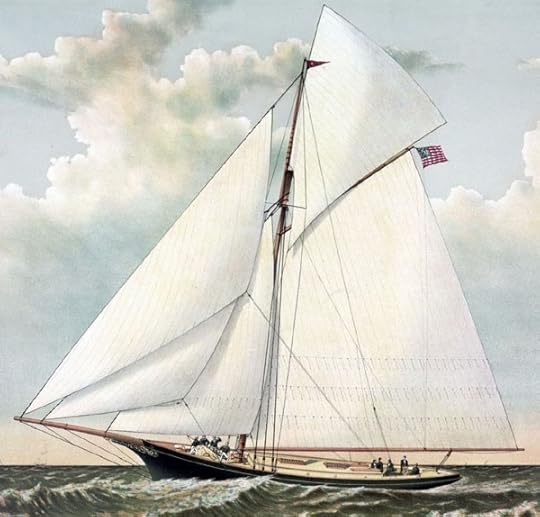
Sloop-of-war (Corvette)
This ship is not to be confused with a sloop. As its name implies, it’s a warship, having a single gun deck with eighteen guns. It is considerably larger than a sloop and often has two masts. Eventually, three-masted versions were built and then resembled a small frigate. However, a frigate is square rigged; sloops-of-war have varying sail configurations, from all square-rigged to ketch riggings or snow riggings (googling this will reveal familiar images). The name corvette was later applied to them. The ships are not rated, having too few guns for the rating system of Britain, but we can rate them as we like on our world (i.e., seventh rate).
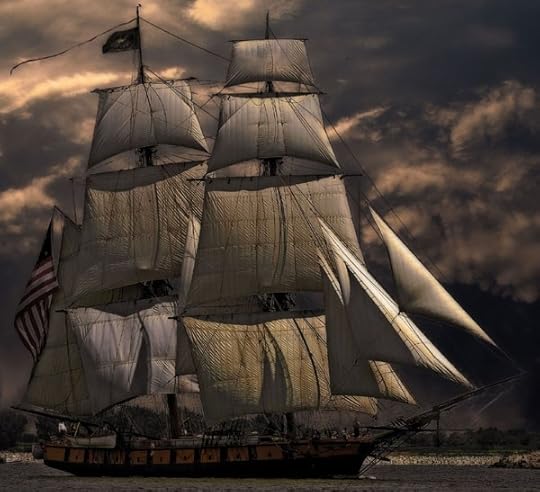
Figure 58 Corvette
The post Sloop vs. Sloop-of-war appeared first on The Art of World Building.
June 10, 2019
Galleons, Ships-of-the-Line
The galleon has two features that distinguish it from other round ships: masts and prow. Like other round ships, it has a mainmast and foremast, but the rear mizzenmast is lateen-rigged. It sometimes has a fourth, even smaller rear mast. This lateen style allows superior sailing that could save days or weeks over long voyages in the open ocean. An instantly recognizable feature is a long beak jutting forward from the prow.
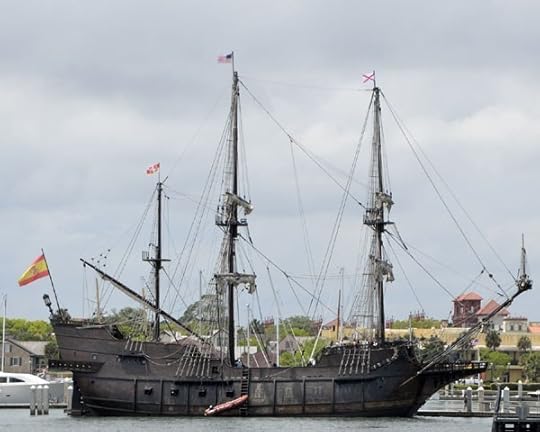
Figure 55 Galleon
For authors, these features require explanation that may gain our audience little in understanding. This is especially true of the beak, which has no functional benefit aside from helping sailors tend to sails, which few readers will care about even if we understand the details of such things and wish to convey them. The beakhead is where sailors crapped, the waste falling directly into the sea, but this is true of all round ships, not just the galleon; oddly, it is the rear of round ships that has an area called “the poop.” This is also from where the expression “I gotta hit the head” originates, as the latrine is at the head of the ship and therefore downwind.
Gun Boats
If we wish to explain to our audience what a galleon is and how it differs from other round ships like the frigate, the difference between square and lateen-rigging and the possible impact on maneuverability and speed is what to mention.
Since our world might not have guns, a new name might be needed for this small vessel that carries one or more large cannons (or whatever missile weapon we invent). They are cheap and easy to build and therefore more expendable. Used in coastal waters, they are no match for large ships, but a score of them can do horrific damage to a lone ship, which can’t sink them all fast enough. This boat is either powered by sails or oars.
Ship-of-the-line
A ship with sixty or more guns, which includes all first, second, and third-rate ships, the ship-of-the-line acquires its name from being designed for the line of battle when two fleets fight each other in two parallel lines. This allows for firing broadsides at each other without fear of hitting their own ships. Smaller ships are not considered strong enough to withstand such a barrage from these vessels, the largest ships afloat, and therefore aren’t part of the line, if present at all.
For an interesting cross-section of the interior of such a vessel, view this diagram: http://www.artofworldbuilding.com/warship.

Figure 56 Ship of the Line
The post Galleons, Ships-of-the-Line appeared first on The Art of World Building.
June 3, 2019
What’s a Round Ship?
Designed for carrying cargo and passengers, the round ships are also used for war and are what we’ve seen in every pirate movie. The round ships primarily use sails for power. When there’s no wind, or an unfavorable one, oars can assist the smaller round ships (up to a frigate in size). Later ships are more maneuverable than long ships like the galley except in calm weather. The round ships mentioned in this chapter are square-rigged on all masts unless otherwise noted.
The man-o-war is not a specific ship type but a generic English name for a three-masted war ship outfitted with soldiers and cannons. This includes the frigate and ship-of-the-line, among others. On our invented world, we can apply the term to similar ships even if an Earth equivalent is not deemed a man-o-war.
While there are many specifications about round ships, the ones listed in this chapter offer a quick comparison regarding ship length, guns, crew, and maximum speeds. Finding definitive answers for each proves somewhat challenging due to conflicting specs cited in various sources. One source might say frigates are from 135-175 feet while another might say they range up to 200. Such details might be insignificant, especially given that, as world builders, we’d be discussing ships on our imagined world, where anything is possible and details could differ at our whim. Still, some effort should be made to know the guidelines before going so far outside of norms as to strain credibility.
To that end, the approach used to compile these specifications was to find reputable sources stating the range of widely accepted possibilities. Further, specific ships of each type with known stats were also considered. In the end, if two sources provided similar numbers, such as 24-40 and 24-44, the larger range is indicated on the chart. If one source provided a number far higher than others, such as 24-40 vs. 24-60, then the higher number was added in parenthesis with a question mark, such as the frigate gun count below, where it reads “24-40 (60?).”
Note that the maximum speed in knots is in ideal conditions with a strong wind on the optimum point of sailing (which direction the wind is blowing in relation to the ship’s heading). No ship experiences such conditions throughout a journey, making the number somewhat useless for determining a trip’s speed. These numbers are mostly for understanding a ship’s capability.
Ship Type
Length in Feet
Guns
Crew
Max Speed (Knots)
Brig
123
10-18
155
11
Frigate
135-212
24-40 (60?)
217-345 (815?)
14
Galleon
140-160
30-74
200-400
10
Gunboat
49-72
1-3
12
14
Ship-of-the-line
150-250
64-140
494-1280
11
Sloop
60
14
75
11
Sloop-of-war
60-110
8-24
112-125
11
What follows in the next articles are some of the more well-known ship types of Earth.
The post What’s a Round Ship? appeared first on The Art of World Building.
June 2, 2019
Brigs, Frigates, and Fire Ships
The brig is a two-masted, square-rigged ship that has a single gun deck. It is fast, highly maneuverable, and can be used as a merchant ship, war ship, or scouting vessel. Pirates frequently employ them. A brig is arguably different from a brigantine but even sailing enthusiasts might disagree over any differences, and historically the names were interchanged; we can use either term. Early brigantines were often outfitted with oars, allowing for movement with poor winds or in and out of harbor more easily.

Figure 53 Brig
Frigates
The frigate is a fast and highly maneuverable, fourth-rate or fifth-rate ship with one gun deck. These are speedy attack ships and often used as scouting vessels for a fleet, escorting, patrolling or acting independently. They are the largest ships used independently because bigger ships are deemed too valuable to risk being captured or destroyed, which is more likely when sailing alone. Some frigates have two gun decks and are called heavy frigates. The term “frigate” is sometimes used generically to refer to quick ships.
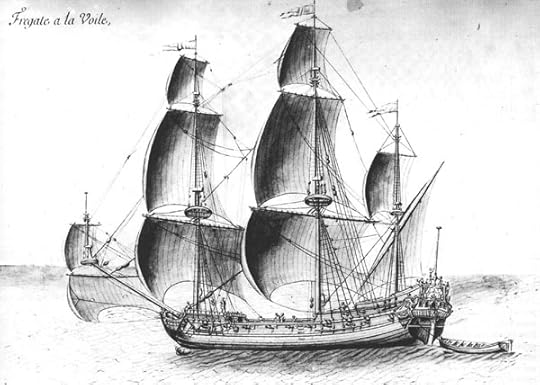
Figure 54 Frigate
Frigates are the same length as higher rated ships but have fewer decks. They carry supplies for six months. Any areas like a forecastle aren’t as tall as ships-of-the-line. They avoid fights with ships-of-the-line due to being outgunned. During a line of battle, they do not join the firing ships but are instead in another row behind them, relaying signals up and down the battle line, as ships-of-the-line can see only the ship before and behind them, making communication difficult. They also aren’t fired upon by the enemy unless they fire first, as it is considered bad etiquette; they are not only smaller but are present to relay messages, not fight.
Fire Ships
Any ship can be turned into a fire ship, but as this means certain destruction to the ship in question, ships that have little to no value are used. The ship is rigged to burn from within the hold, where specially designed tubes vent the flames toward enemy ships and the rigging. The ship is sent floating into the general melee of a sea battle during engagements between fleets; it isn’t something we’d see sailing around by itself. We might assume that something as valuable as a ship-of-the-line is an unlikely fire ship even if damaged beyond any other use; too many men would be required to sail it into position and then abandon it for other ships, but it could be done.
The post Brigs, Frigates, and Fire Ships appeared first on The Art of World Building.
May 30, 2019
What’s a Long Ship?
While we could invent a new ship, there’s little reason to, for several reasons. We aren’t likely to engineer something that would stay afloat if constructed, but a large variety of ship types are available to us already. Within each type, even more variety is to be found. This means we once again have leeway to make alterations of our own if we need to, provided we get the basics right. Naval terminology regarding ships was somewhat flexible at times, but settled into more definitive terms. This works to our advantage because we can get things approximately correct and fudge details for our uses. In addition, audiences seldom know much about existing ships and probably don’t thirst for something new. For these reasons, we’ll look at the more prominent, existing ships, not learn how to build new ones.
Vessels comes in two groups: long ships and round ships. The latter aren’t circular, of course, but are called this because they are wide when compared to the narrow and streamlined long ships like those used by Vikings.
Long Ships
The earliest vessels are the long ships, which are largely powered by oars but also have sails for additional propulsion. The galley is the primary type, and there are variations on it. All were designed for war or swift transportation, as opposed to carrying cargo.
Galley
Synonymous with Vikings but used elsewhere, the galley is the basic vessel powered by strong, highly trained rowers. It often includes a single mast and a metal-shod prow for ramming, an act followed by boarding. It is highly maneuverable but has a wide turning arc and requires calm weather. It is also not for open seas (despite being occasionally used this way) and is consequently found along coastlines. The invention and addition of firearms to ships caused this type to fall into disuse on Earth, but if our world doesn’t have gunpowder or similarly powered gunnery, the galley might still be favored.
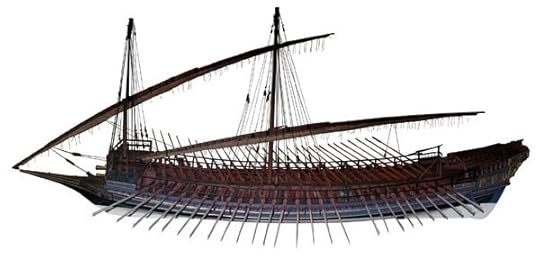
Figure 51 Galley
The later, 17th century galley on Earth had two masts and a captain’s cabin at the rear, which adds usefulness to us as storytellers simply because a room exists in which conversations or acts not for others to witness may take place. If using this type of galley, we need another name for it, such as naming it after a sovereign power from which it’s thought to have originated.
The galley type known as a galleass is quite large, having both a rear and forecastle for artillery and soldiers, and up to twenty-five oars per side, each oar rowed by five men. Above the rower’s heads might be a deck for soldiers and operation of sails and gunnery. This ship wasn’t as fast and often served in the vanguard of an armada as a commander’s vessel.
The post What’s a Long Ship? appeared first on The Art of World Building.
May 27, 2019
Ship Rates in the British Navy
In the British Navy, ships were rated based on the number of guns and personnel. This is something authors can mention but screenwriters might find hard to work into a conversation without being obvious about it. In either case, if we have a character say, “That’s a first-rate ship,” people will assume that means “it’s a quality ship,” not that it means the ship has over a hundred guns and more than eight hundred crew and is therefore in the biggest class of ships. The same applies to “second-rate” and so on, with many audiences assuming the ship is inferior when this isn’t true. The ratings are not a judgement of quality, though in the “bigger is better” mentality, it is. Beware of this when writing about it.
Whether we emulate this or not, here is a basic rundown, according to Men-of-War, Life in Nelson’s Navy by Patrick O’Brian:
“First rate 100-112 guns, 841 men (including officers, seamen, boys, and servants)
Second rate 90-98 guns, 743 men
Third rate 64, 74 and 80 guns, 494, about 620, and 724 men
Fourth rate 50 guns, 345 men
Fifth rate 32, 36, 38, and 44 guns, 217-297 men
Sixth rate 20, 24, and 28 guns, 128, 158, and 198 men.”
Anything with fewer guns wasn’t rated and all the above had three masts. Not including the forecastle and quarterdeck, the first and second-rate ships had three full decks for just the guns. Third and fourth rate had two gun decks and the rest had one gun deck. With multiple gun decks, the guns on the lower decks were the biggest and this was where crew slept and ate. High decks had increasingly smaller guns and cannonballs for the obvious reason of not making the ship top heavy. Weaponry is discussed later in this chapter.
This large image of a third-class man-o-war gives a great view of the rigging and even interior of a vessel: http://www.artofworldbuilding.com/warship.
The post Ship Rates in the British Navy appeared first on The Art of World Building.
May 23, 2019
What’s a Mast, Yard, and Sail?
A few basic terms are helpful to know. This is not an exhaustive list of nomenclature, just what we need to know to understand the differences between vessels.
Masts
A mast stands vertically from any ship that has sails. There can be more than one, depending on ship size and type. The center mast is the tallest and called the main mast. The mast at the bow (front of the ship) is the foremast and is shorter. The rear one, should it exist, is called the mizzen mast, and is the shortest. In a two-masted ship, the mizzen mast is the omitted one; however, the other two masts are farther back in the ship’s body.
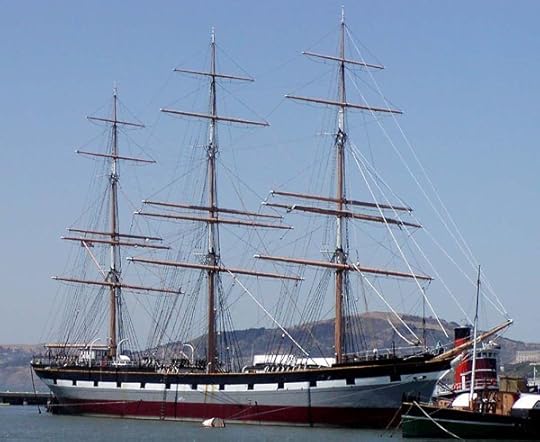
Figure 48 Ship with Three Masts
Yards
Each mast will have at least one yard, to which the sails are attached. In many ships, the yard is horizontal. If perpendicular, or square, to the ship’s length, the ship is “square-rigged”. Most ships have from one to three yards of different lengths and thicknesses. By contrast, in lateen-rigged ships, the yard is sloped, running parallel to the ship’s length, one end pointing at the sky, and there’s only one per mast. The yards have names but these aren’t needed to understand this chapter.
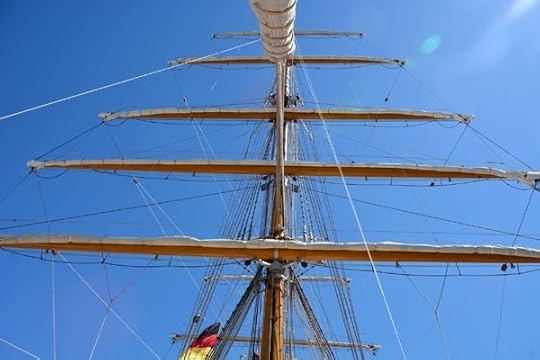
Figure 49 Horizontal Yards
Some ships have a combination of square and lateen rigging. This usually means the main and foremast are square while the mizzen is lateen. This will be mentioned further when looking at actual ship types.
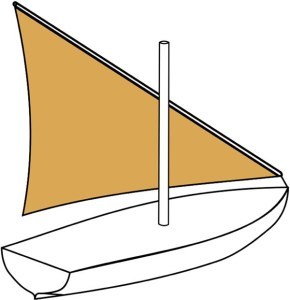
Figure 50 Lateen Sail
Sails
In square-rigged ships, the sails are a trapezoid, being wider at the bottom than the top. On a lateen-rigged ship, a triangular sail is used. This is sometimes called fore-and-aft rigging because that’s how the yard is aligned (forward and aft, or rear). This rigging allows for a closer point of sail on the wind, being more maneuverable. It takes advantage of rapidly changing winds such as in the Mediterranean, but in the open ocean, winds are more constant and a square-rigged ship does not suffer a disadvantage. Sails can be configured in many ways, most of which will confuse anyone not familiar with them, but this resource goes into more detail: http://www.artofworldbuilding.com/sails.
The post What’s a Mast, Yard, and Sail? appeared first on The Art of World Building.
May 20, 2019
Travel By Water
If you’re a landlubber like me, you have little to no idea how long it takes a ship to sail from one place to another. That will change by the end of this chapter, but we have considerable leeway in deciding the length of any journey. Much of what follows here is about travel under sail, or by rowing, not by engines. In fantasy worlds, those engines are implausible. In SF, travel is typically through the air. The speed calculations in the section on ship speeds can apply to engine-powered ships as well, since a knot is a knot and it doesn’t matter what’s causing this speed, with the caveat that winds and oars cannot produce the constant speed of engines.
Several factors influence the difficulty of sailing between locations. The wind direction is chief among them. The ship building skills and seamanship of various countries also impacts this. All of it influences trade routes and which nations can conquer others. A ship would not be able to sail directly into a headwind. Taking an alternative route might force a ship closer to an enemy coastline.
There are several reasons we have leeway in determining the duration of a ship journey:
Our map, should one exist, is not drawn to scale
Oarsmen cannot row indefinitely and might have different levels of endurance and training from ship to ship
Wind speed is not constant even in the open ocean, affecting both the ship itself (if sail powered) and the height of waves that could further impact speed
Wind direction is also not constant, affecting the angle at which wind fills sails
Different types of ships sail at different speeds under the same conditions
Our ship is weighed down by people, cargo, food, and weapons/ammunition, any one of which can change in quantity during a voyage. A ship that just left dock is heavier than one at sea for six months, unless the latter is laden with treasure
Our ship might be damaged
Our ship is sailing on a fictitious planet, with possibly a different number of moons and whatever else might affect the seas
Maybe it comes as no surprise that we aren’t sure how long a trip will take. What we’re looking for is a reasonable approximation that a ship will take between X and Z number of hours to travel Y number of miles/kilometers, depending on conditions. But we don’t have to do this. We can just invent numbers and not worry about it. Never stating the distance between two places helps this. Grounding our numbers in some real-world knowledge is an approach that more serious world builders might want to employ, especially if we intend to reuse the setting. Otherwise, we might be inconsistent. Regardless of our choice, the knowledge can help inspire believable details in our work.
For example, let’s say that for our story, we need a trip to take 24 hours, but our calculations reveal that a ship usually takes 24-30 hours. We’re in luck and can do it. When describing that journey, we could state that our sailors enjoyed nearly ideal conditions. This could allow for characters to undertake sword practice on deck or another activity requiring surer footing. A wizard could have time to mix materials needed for spells.
In another scenario, maybe we want our characters to feel confident they’ll make that trip in time. But we want to surprise them and make them arrive late, in 34 hours. We can throw up a storm to slow them, making a character sea sick and preventing others from doing much of anything. Or maybe they battle a ship or sea monster and in so doing lose a mast despite their victory.
We don’t have to do these things, but stories always need unexpected challenges, and if the sea isn’t hard to predict, nothing in our world is.
The post Travel By Water appeared first on The Art of World Building.
May 2, 2019
Getting Starting with Travel Issues
Determining the distance between locations for which we want to calculate travel times should be an early decision. Take terrain changes between each pair of locations into account. Then decide which travel methods will be used in your books; there’s no sense in calculating dragons’ travel time if they don’t exist in your world. Review the base miles per day that this book provides and alter them to suit your judgment. Do the same for terrain and other modifiers. Now you’re ready to calculate the travel times. The easiest method is to use the pre-set ones provided. Otherwise, carefully study the equations in this chapter and the Excel spreadsheet and apply them as needed.
The post Getting Starting with Travel Issues appeared first on The Art of World Building.




